
All Saints Episcopal Church, built in 1872-1873, is an historic Carpenter Gothic church in Saugatuck, Michigan. On February 27, 1984, it was added to the National Register of Historic Places.

St. John's Episcopal Church is an antebellum-era church located at 2326 Woodward Avenue in Downtown Detroit, Michigan. It is the oldest church still standing on Woodward Avenue, an area once called Piety Hill for its large number of religious buildings. The church was listed on the National Register of Historic Places in 1982 and designated a Michigan State Historic Site in 1987.

The Saint Michael and All Angels Episcopal Church is a historic church located in rural Cambridge Township in northwestern Lenawee County, Michigan. The church was designated as a Michigan Historic Site on October 2, 1980. On February 4, 2004, the church, along with the adjacent Cambridge Township Cemetery, was added to the National Register of Historic Places.
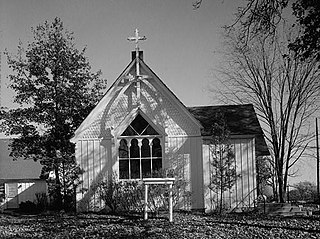
St. Katherine's Chapel, also known as St. Katherine's Episcopal Chapel, is an historic Episcopal church building located at 4650 North Meridian Road in Williamston Township, near Williamston, Michigan.

Grace Episcopal Church is a historic church at 360 East Chicago Street in Jonesville, Michigan. It was designated a Michigan State Historic Site and listed on the National Register of Historic Places in 1971. It is one of the first church buildings constructed in Michigan west of Detroit, and is one of the few surviving examples of indigenous church architecture in the state.
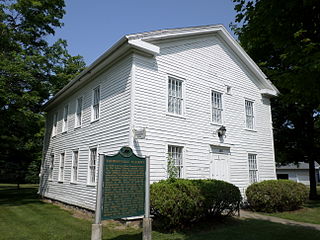
The Vermontville Academy, also known as the First Congregational Chapel, is a building in Vermontville, Michigan, located oat 106 North Main Street. It was listed on the National Register of Historic Places in 1972, and is part of the Historic American Buildings Survey. It now serves as the Vermontville Historical Museum.

Saint Joseph's Catholic Church is a church located at 5899 County Road 669 near Maple City, Michigan and east of Glen Arbor, Michigan. It was constructed in 1884 and listed on the National Register of Historic Places in 1992.

St. Paul's Episcopal Church is a historic church complex in Watertown, Wisconsin, with its different buildings displaying different phases of Gothic Revival architecture. In 1979 it was added to the National Register of Historic Places for its architectural significance.

The Chelsea Commercial Historic District is a historic district located along both sides of Main Street from Orchard to North Street in Chelsea, Michigan; the district also includes the adjacent 100 blocks of Jackson, East Middle, and West Middle Streets, as well as structures on Park, East, and Orchard Streets. It was listed on the National Register of Historic Places in 2011.

The Griswold Civic Center Historic District is a small historic district containing eight civic and religious buildings, roughly bounded by Hubbard, Walnut, and Trowbridge Streets, in Allegan, Michigan. It was added to the National Register of Historic Places in 1987.
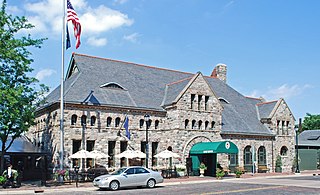
The Ann Arbor station is a former Michigan Central Railroad station located at 401 Depot Street in Ann Arbor, Michigan. It was converted into a restaurant, the Gandy Dancer, in 1970, and listed on the National Register of Historic Places as Michigan Central Railroad Depot in 1975.

The University Of Michigan Central Campus Historic District is a historic district consisting of a group of major buildings on the campus of the University of Michigan in Ann Arbor, Michigan. It was listed on the National Register of Historic Places in 1978.

The Northern Brewery is a former industrial building located at 1327 Jones Drive in Ann Arbor, Michigan. It was listed on the National Register of Historic Places in 1979.
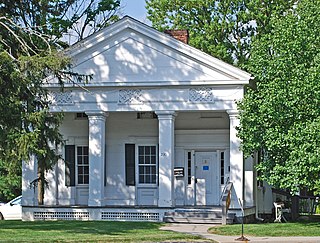
The William Anderson House is a single-family home located at 2301 Packard Road in Ann Arbor, Michigan. It was listed on the National Register of Historic Places in 1983.

The Germania Building Complex consists of two adjacent related buildings located at 119-123 West Washington Street and 209-211 Ashley Street in Ann Arbor, Michigan. The buildings were listed on the National Register of Historic Places in 1983.

The North Ann Arbor Street Historic District is a residential historic district, consisting of the houses at 301, 303, and 305-327 North Ann Arbor Street in Saline, Michigan. It was listed on the National Register of Historic Places in 1985.

The Thomas Earl House was built as a single-family home located at 415 North Main Street in Ann Arbor, Michigan. It was listed on the National Register of Historic Places in 1992. The house has been renovated to office space.
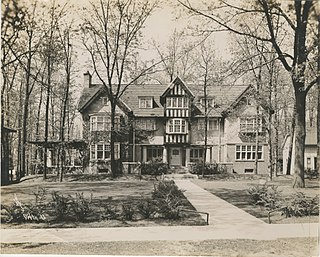
The Delta Upsilon Fraternity House is a fraternity house located at 1331 Hill Street in Ann Arbor, Michigan. It was listed on the National Register of Historic Places in 1995.

The Floyd R. Mechem House is a single-family home located at 1402 Hill Street in Ann Arbor, Michigan. It was listed on the National Register of Historic Places in 1999.

The Ann Arbor Railway Howell Depot is a railroad depot located at 128 Wetmore Street in Howell, Michigan. It was listed on the National Register of Historic Places in 1971. The depot is currently used as the Howell Depot Museum.




























